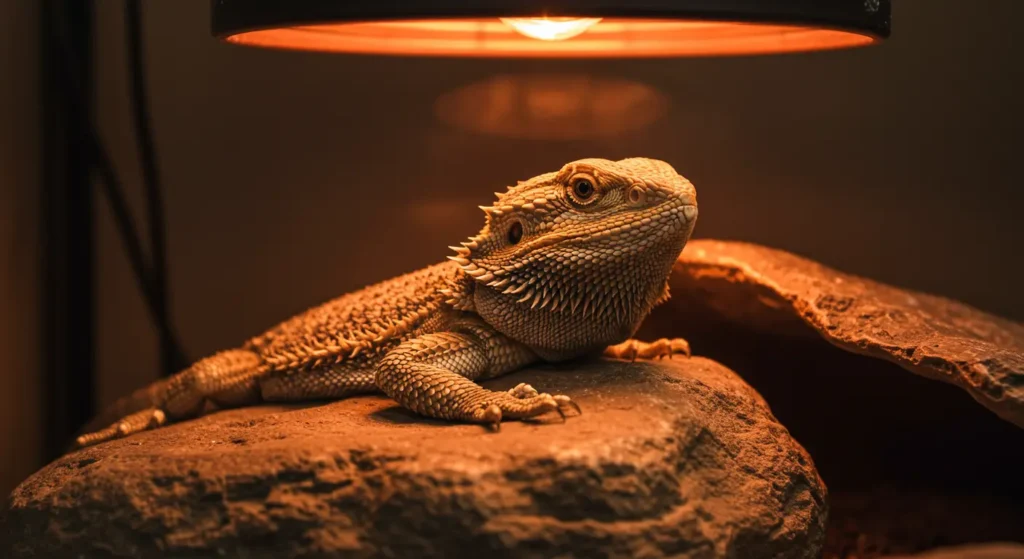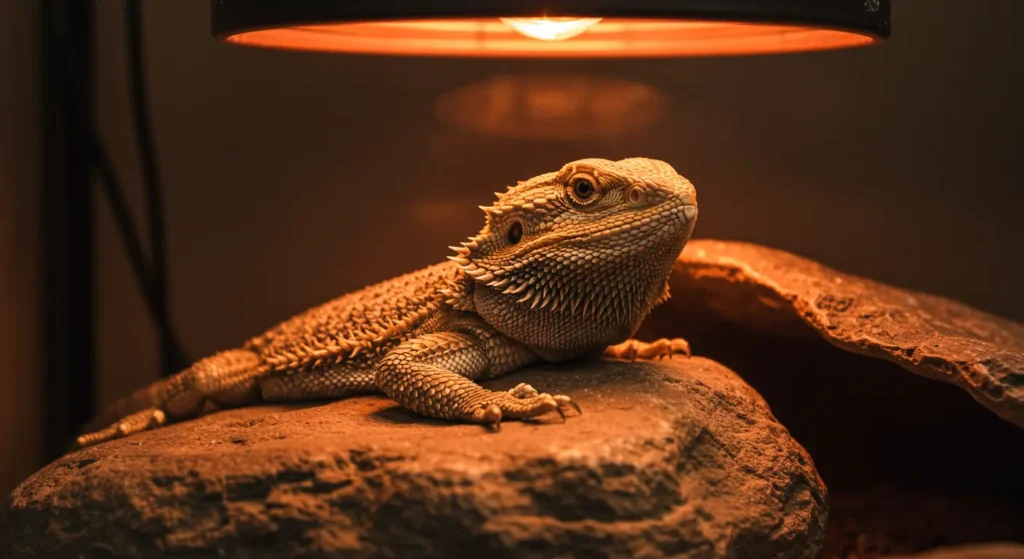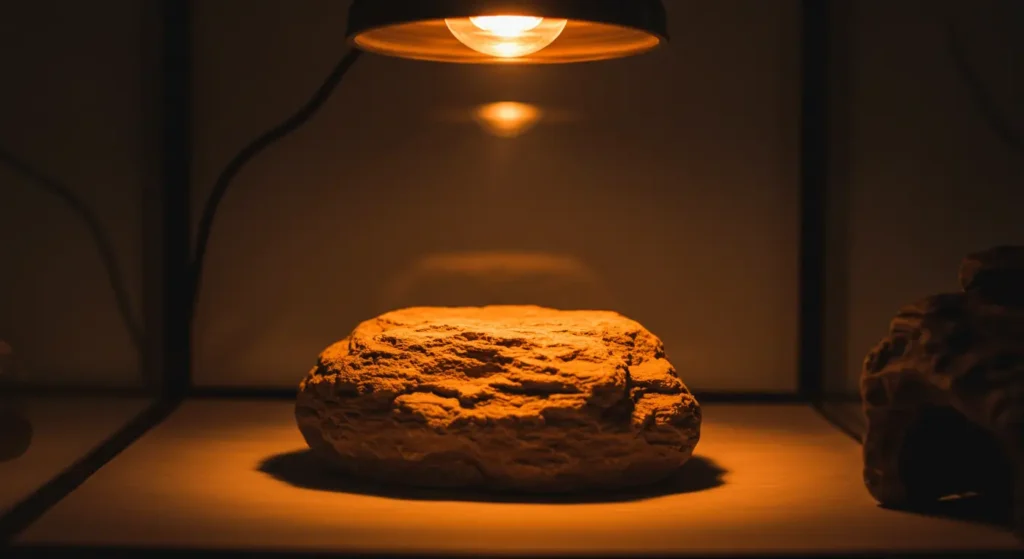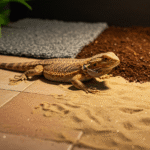Do bearded dragons need a basking rock? It’s a question every responsible reptile owner should ask—and the answer isn’t as straightforward as you might think. While basking rocks may seem like just another accessory, they actually play a vital role in replicating the natural environment your bearded dragon depends on for survival.
In this guide, we’ll explore whether bearded dragons need a basking rock for proper thermoregulation, digestion, and comfort inside their enclosure. We’ll also look at what happens when this simple but powerful tool is missing—and how the right basking setup can significantly improve your dragon’s health and daily behavior.
Whether you’re setting up a tank for the first time or looking to upgrade your bearded dragon’s habitat, understanding the real purpose of a basking rock is essential. Let’s dive in.
Do Bearded Dragons Need a Basking Rock? The Simple Answer is Yes
When it comes to basking, bearded dragons thrive with the help of a solid, heat-retaining surface—and that’s exactly what a basking rock provides. So, do bearded dragons need a basking rock? The simple answer is yes—because it supports their natural instincts, health, and comfort in captivity.
Why Bearded Dragons Bask in the Wild
In the wild, bearded dragons live in arid regions of Australia. These environments have intense sun and sharp temperature shifts between day and night. To survive, bearded dragons bask in the sun during the day. This allows them to absorb heat and gain the energy they need for daily activity. Basking is a natural behavior deeply tied to their instincts.

How Cold-Blooded Reptiles Regulate Body Temperature
Bearded dragons are cold-blooded, meaning they cannot generate their own body heat. Instead, they rely entirely on external heat sources. Basking under the sun—or a heat lamp in captivity—helps them raise their internal temperature to functional levels. Once warmed up, they can move, eat, and digest properly. Without access to heat, their body processes slow down.
The Connection Between Basking and Digestion
Heat plays a vital role in a bearded dragon’s ability to digest food. After eating, they often return to their basking spot to warm up. This external heat boosts their metabolism and helps break down food more efficiently. Without proper basking, digestion slows, leading to issues like bloating, impaction, or even appetite loss. A warm basking area is as important as a proper diet.
What Happens When They Don’t Get Enough Heat
When a bearded dragon can’t bask properly, several health problems can follow. They may become sluggish, stop eating, or show signs of stress. Long-term lack of heat can weaken their immune system and lead to serious illness. In some cases, it may even cause metabolic bone disease due to poor calcium absorption. A warm, consistent basking routine is essential to avoid these risks.
Do Bearded Dragons Need a Basking Rock in Captivity?
In captivity, recreating a bearded dragon’s natural habitat is crucial for their health and well-being. Do bearded dragons need a basking rock in captivity? Yes—because it mimics the sun-warmed surfaces they rely on in the wild, helping them regulate temperature, digest food, and stay active.
How Basking Rocks Simulate Natural Heat Sources
In the wild, bearded dragons bask on sun-warmed rocks. These surfaces store heat and release it slowly, even after the sun moves. A basking rock in captivity does the same. When placed under a heat lamp, it absorbs warmth and becomes a consistent heat source. This helps mimic the dragon’s natural environment and supports healthy basking behavior.
Benefits of Basking Rocks Over Other Surfaces
Not all basking spots offer the same value. Basking rocks are dense and retain heat longer than flat platforms or tile. Their textured surface also gives dragons better grip and comfort. Unlike plastic or metal, natural rocks don’t overheat quickly or cool down too fast. They provide steady, safe warmth—ideal for thermoregulation and relaxation.
Do Heat Lamps Alone Provide Enough Warmth?
Heat lamps are essential, but not always enough on their own. They provide overhead warmth but don’t offer a surface that stores and radiates heat. Without a basking rock, the heat may dissipate too quickly—especially in cooler rooms. Combining a basking rock with a heat lamp ensures your dragon gets warmth from both above and below, just like in the wild.
When a Basking Rock Becomes Essential for Enclosure Setups
Some tank setups make basking rocks more than just helpful—they become essential. In tall enclosures or cooler climates, heat may not reach the floor effectively. A properly placed basking rock helps concentrate heat where your dragon needs it most. It’s also crucial for young or sick dragons that require consistent warmth for recovery or growth.
Choosing the Right Basking Surface for Your Reptile
Choosing the right basking surface is essential for your bearded dragon’s health and comfort. Different materials affect heat retention and safety in unique ways. To learn more about setting up the perfect basking area and overall tank layout, check out this Essential Guide: How to Set Up the Perfect Basking Area for Your Bearded Dragon. This section will help you understand the best options to create an ideal basking spot.
Basking Rock vs. Basking Platform: Pros and Cons
Basking rocks naturally retain heat and provide a textured surface for your dragon to grip. They closely mimic the warm surfaces found in the wild, offering a more authentic basking experience. However, they can be heavy and more difficult to clean. On the other hand, basking platforms are lightweight and easier to move or sanitize. Many platforms are made from plastic or wood, which do not hold heat as effectively as natural stone. Choosing between the two depends on your enclosure design and your dragon’s preferences.
Materials to Avoid (Plastic, Sharp Stone, Heated Rocks)
Not all basking surfaces are safe for bearded dragons. Avoid plastic platforms because they can warp or melt near heat sources. Sharp stones can injure your dragon’s feet or skin. Heated rocks that plug into outlets are especially dangerous—they can overheat and cause burns. Always opt for non-toxic, stable, and heat-resistant materials like smooth ceramic or slate rocks to keep your pet safe.
How to Test Heat Retention and Safety
Testing your basking surface is vital to ensure it maintains a safe and comfortable temperature. Use a reliable thermometer to check surface temps during peak basking hours. The ideal basking surface temperature ranges between 95°F and 110°F. Make sure the edges stay cooler to prevent burns. Also, observe your bearded dragon’s behavior—if it avoids the surface, it may be too hot or uncomfortable.
Matching the Basking Surface to Tank Size and Layout
Your basking surface should fit well within your enclosure without overcrowding. In smaller tanks, opt for compact basking rocks or platforms. Larger tanks can accommodate bigger or multiple basking spots, allowing your dragon to move freely. Position the basking area thoughtfully to create a proper heat gradient and easy access for your dragon.
Creating the Ideal Temperature Gradient in the Enclosure
A proper temperature gradient inside the enclosure is vital for your bearded dragon’s wellbeing. It lets your pet regulate its body temperature naturally by moving between hot and cool zones. Here, we explain how to create and maintain the perfect thermal environment.
Importance of Hot and Cool Zones
Bearded dragons rely on distinct hot and cool zones to control their body temperature. The hot zone provides the warmth they need to become active and digest food properly. The cool zone lets them cool down when they overheat. Without a proper gradient, your dragon risks stress, illness, and improper metabolism.

Ideal Basking Temperature for Adult and Baby Dragons
Adult bearded dragons thrive with basking temperatures between 95°F and 110°F. Babies require slightly warmer spots, usually between 105°F and 115°F, because they are more vulnerable to temperature swings. Maintaining these ranges supports healthy metabolism, digestion, and overall activity.
Tools to Monitor and Maintain Tank Temperatures
Accurate temperature monitoring tools are key to a safe enclosure. Use digital thermometers, infrared sensors, or thermostat-controlled heat lamps to keep tabs on both hot and cool zones. Regular checks and adjustments ensure your dragon always has access to the right temperatures.
UVB Lighting vs. Heat Lighting—What Each Does
Heat lighting provides essential warmth for thermoregulation and digestion. UVB lighting helps your bearded dragon produce vitamin D3, which is critical for calcium absorption and bone health. Both lights are necessary but serve different functions. Proper placement and timing maximize their benefits and keep your pet healthy.
Common Mistakes When Setting Up a Basking Area
Setting up a proper basking area is crucial for your bearded dragon’s health, but many owners unknowingly make mistakes. Avoiding these common errors can help ensure your pet stays safe, comfortable, and healthy. This section highlights key pitfalls and how to prevent them.
Placing the Rock Too Far from the Heat Source
One common mistake is positioning the basking rock too far from the heat lamp. If the rock doesn’t get warm enough, your dragon won’t benefit from proper heat retention. The basking rock needs to be close enough to absorb and radiate heat effectively. Otherwise, your bearded dragon may avoid the area and miss out on essential warmth.
Relying Only on Heat Rocks or Ceramic Emitters
Heat rocks and ceramic heat emitters are popular, but relying solely on them can be risky. Heat rocks that plug into outlets can overheat and cause burns. Ceramic emitters provide heat but do not emit light, so your dragon might miss visual cues for basking. Combining these with other heat sources like heat lamps and basking rocks creates a safer, more natural environment.
Using Unsafe or Unstable Basking Materials
Using unstable or unsafe basking materials can cause injuries or stress. Avoid sharp stones that might hurt your dragon’s feet. Lightweight or flimsy platforms may tip over, risking injury. Always choose sturdy, heat-resistant surfaces that provide good traction and stability.
Ignoring Your Dragon’s Behavior and Basking Patterns
Every bearded dragon has unique basking habits. Ignoring your pet’s behavior can lead to missed signs of discomfort or health issues. Pay attention to where and how long your dragon basks. If it avoids the basking area, the temperature or setup may need adjustment. Regular observation helps you tailor the basking environment to your dragon’s needs. For insights into their feeding habits, including whether they can safely eat earthworms, check out Can a Bearded Dragon Eat Earthworms Raw? Vet Advice Inside.
Conclusion
Understanding whether bearded dragons need a basking rock is essential for providing the best care possible. A proper basking surface not only mimics their natural environment but also supports crucial functions like thermoregulation and digestion. By choosing the right materials, creating an ideal temperature gradient, and avoiding common setup mistakes, you ensure your bearded dragon stays healthy, comfortable, and active.
Investing time in setting up a safe and effective basking area pays off in your pet’s overall well-being. Remember, attention to your dragon’s behavior and needs will help you make adjustments that keep their habitat perfect. With the right setup, your bearded dragon can thrive and enjoy a long, happy life.







1 thought on “Do Bearded Dragons Need a Basking Rock to Thrive?”